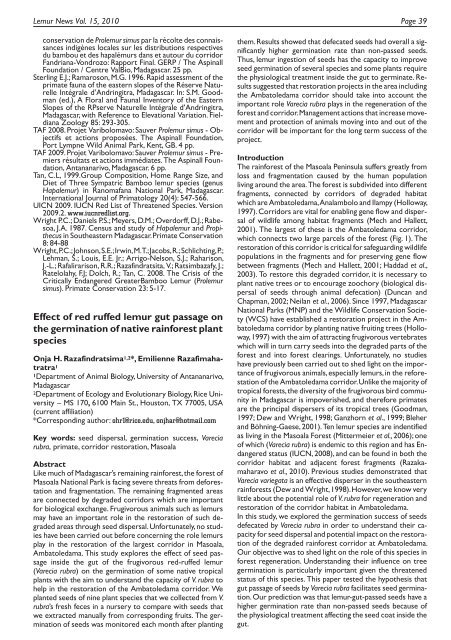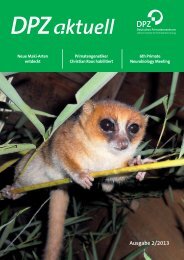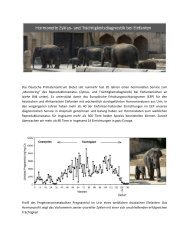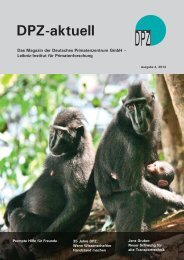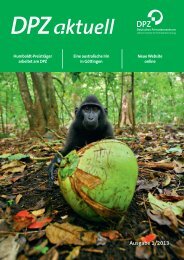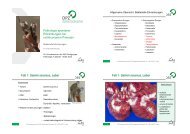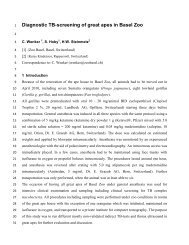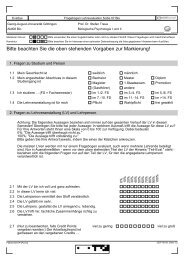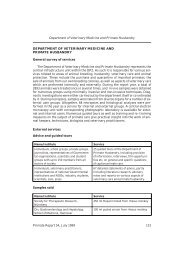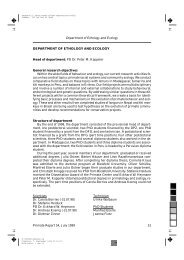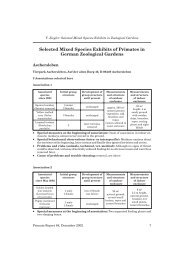Vol. 15 - Deutsches Primatenzentrum
Vol. 15 - Deutsches Primatenzentrum
Vol. 15 - Deutsches Primatenzentrum
Create successful ePaper yourself
Turn your PDF publications into a flip-book with our unique Google optimized e-Paper software.
Lemur News <strong>Vol</strong>. <strong>15</strong>, 2010 Page 39<br />
conservation de Prolemur simus par la récolte des connaissances<br />
indigènes locales sur les distributions respectives<br />
du bambou et des hapalémurs dans et autour du corridor<br />
Fandriana-Vondrozo: Rapport Final. GERP / The Aspinall<br />
Foundation / Centre ValBio, Madagascar. 25 pp.<br />
Sterling E.J.; Ramaroson, M.G. 1996. Rapid assessment of the<br />
primate fauna of the eastern slopes of the Réserve Naturelle<br />
Intégrale d’Andringitra, Madagascar. In: S.M. Goodman<br />
(ed.), A Floral and Faunal Inventory of the Eastern<br />
Slopes of the RPserve Naturelle Intégrale d’Andringitra,<br />
Madagascar, with Reference to Elevational Variation. Fieldiana<br />
Zoology 85: 293-305.<br />
TAF 2008. Projet Varibolomavo: Sauver Prolemur simus -Objectifs<br />
et actions proposées. The Aspinall Foundation,<br />
Port Lympne Wild Animal Park, Kent, GB. 4 pp.<br />
TAF 2009. Projet Varibolomavo: Sauver Prolemur simus -Premiers<br />
résultats et actions immédiates. The Aspinall Foundation,<br />
Antananarivo, Madagascar. 6 pp.<br />
Tan, C.L, 1999.Group Composition, Home Range Size, and<br />
Diet of Three Sympatric Bamboo lemur species (genus<br />
Hapalemur) in Ranomafana National Park, Madagascar.<br />
International Journal of Primatology 20(4): 547-566.<br />
UICN 2009. IUCN Red List of Threatened Species. Version<br />
2009.2. www.iucnredlist.org.<br />
Wright P.C.; Daniels P.S.; Meyers, D.M.; Overdorff, D.J.; Rabesoa,<br />
J.A. 1987. Census and study of Hapalemur and Propithecus<br />
in Southeastern Madagascar.Primate Conservation<br />
8: 84-88<br />
Wright,P.C.;Johnson,S.E.;Irwin,M.T.;Jacobs,R.;Schlichting,P.;<br />
Lehman, S.; Louis, E.E. Jr.; Arrigo-Nelson, S.J.; Raharison,<br />
J.-L.; Rafalirarison, R.R.; Razafindratsita, V.; Ratsimbazafy, J.;<br />
Ratelolahy, F.J; Dolch, R.; Tan, C. 2008. The Crisis of the<br />
Critically Endangered GreaterBamboo Lemur (Prolemur<br />
simus). Primate Conservation 23: 5-17.<br />
Effect of red ruffed lemur gut passage on<br />
the germination of native rainforest plant<br />
species<br />
Onja H. Razafindratsima 1,2*, Emilienne Razafimahatratra<br />
1<br />
1Department of Animal Biology, University of Antananarivo,<br />
Madagascar<br />
2Department of Ecology and Evolutionary Biology, Rice University<br />
– MS 170, 6100 Main St., Houston, TX 77005, USA<br />
(current affiliation)<br />
*Corresponding author: ohr1@rice.edu, onjhar@hotmail.com<br />
Key words: seed dispersal, germination success, Varecia<br />
rubra, primate, corridor restoration, Masoala<br />
Abstract<br />
Like much of Madagascar’s remaining rainforest,the forest of<br />
Masoala National Park is facing severe threats from deforestation<br />
and fragmentation. The remaining fragmented areas<br />
are connected by degraded corridors which are important<br />
for biological exchange. Frugivorous animals such as lemurs<br />
may have an important role in the restoration of such degraded<br />
areas through seed dispersal. Unfortunately,no studies<br />
have been carried out before concerning the role lemurs<br />
play in the restoration of the largest corridor in Masoala,<br />
Ambatoledama. This study explores the effect of seed passage<br />
inside the gut of the frugivorous red-ruffed lemur<br />
(Varecia rubra) on the germination of some native tropical<br />
plants with the aim to understand the capacity of V. rubra to<br />
help in the restoration of the Ambatoledama corridor. We<br />
planted seeds of nine plant species that we collected from V.<br />
rubra’s fresh feces in a nursery to compare with seeds that<br />
we extracted manually from corresponding fruits. The germination<br />
of seeds was monitored each month after planting<br />
them. Results showed that defecated seeds had overall a significantly<br />
higher germination rate than non-passed seeds.<br />
Thus, lemur ingestion of seeds has the capacity to improve<br />
seed germination of several species and some plants require<br />
the physiological treatment inside the gut to germinate. Results<br />
suggested that restoration projects in the area including<br />
the Ambatoledama corridor should take into account the<br />
important role Varecia rubra plays in the regeneration of the<br />
forest and corridor.Management actions that increase movement<br />
and protection of animals moving into and out of the<br />
corridor will be important for the long term success of the<br />
project.<br />
Introduction<br />
The rainforest of the Masoala Peninsula suffers greatly from<br />
loss and fragmentation caused by the human population<br />
living around the area.The forest is subdivided into different<br />
fragments, connected by corridors of degraded habitat<br />
which are Ambatoledama,Analambolo and Ilampy (Holloway,<br />
1997). Corridors are vital for enabling gene flow and dispersal<br />
of wildlife among habitat fragments (Mech and Hallett,<br />
2001). The largest of these is the Ambatoledama corridor,<br />
which connects two large parcels of the forest (Fig. 1). The<br />
restoration of this corridor is critical for safeguarding wildlife<br />
populations in the fragments and for preserving gene flow<br />
between fragments (Mech and Hallett, 2001; Haddad et al.,<br />
2003). To restore this degraded corridor, it is necessary to<br />
plant native trees or to encourage zoochory (biological dispersal<br />
of seeds through animal defecation) (Duncan and<br />
Chapman, 2002; Neilan et al., 2006). Since 1997, Madagascar<br />
National Parks (MNP) and the Wildlife Conservation Society<br />
(WCS) have established a restoration project in the Ambatoledama<br />
corridor by planting native fruiting trees (Holloway,1997)<br />
with the aim of attracting frugivorous vertebrates<br />
which will in turn carry seeds into the degraded parts of the<br />
forest and into forest clearings. Unfortunately, no studies<br />
have previously been carried out to shed light on the importance<br />
of frugivorous animals,especially lemurs,in the reforestation<br />
of the Ambatoledama corridor.Unlike the majority of<br />
tropical forests,the diversity of the frugivorous bird community<br />
in Madagascar is impoverished, and therefore primates<br />
are the principal dispersers of its tropical trees (Goodman,<br />
1997; Dew and Wright, 1998; Ganzhorn et al., 1999; Bleher<br />
and Böhning-Gaese,2001).Ten lemur species are indentified<br />
as living in the Masoala Forest (Mittermeier et al., 2006); one<br />
of which (Varecia rubra) is endemic to this region and has Endangered<br />
status (IUCN, 2008), and can be found in both the<br />
corridor habitat and adjacent forest fragments (Razakamaharavo<br />
et al., 2010). Previous studies demonstrated that<br />
Varecia variegata is an effective disperser in the southeastern<br />
rainforests (Dew and Wright,1998).However,we know very<br />
little about the potential role of V.rubra for regeneration and<br />
restoration of the corridor habitat in Ambatoledama.<br />
In this study, we explored the germination success of seeds<br />
defecated by Varecia rubra in order to understand their capacity<br />
for seed dispersal and potential impact on the restoration<br />
of the degraded rainforest corridor at Ambatoledama.<br />
Our objective was to shed light on the role of this species in<br />
forest regeneration. Understanding their influence on tree<br />
germination is particularly important given the threatened<br />
status of this species. This paper tested the hypothesis that<br />
gut passage of seeds by Varecia rubra facilitates seed germination.<br />
Our prediction was that lemur-gut-passed seeds have a<br />
higher germination rate than non-passed seeds because of<br />
the physiological treatment affecting the seed coat inside the<br />
gut.


